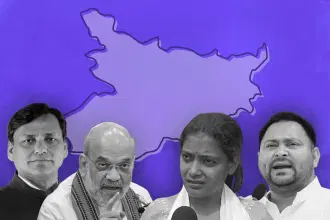Books
Ittefaq, Etmad, Qurbani: On Bose And The Making Of An Inconvenient Front
Prem Ansh Sinha
Aug 09, 2025, 07:30 AM | Updated 09:42 AM IST
Save & read from anywhere!
Bookmark stories for easy access on any device or the Swarajya app.


Bose. Chandrachur Ghosh. Penguin Random House India. Pages: 727. Price: Rs 699
On Subhas Chandra Bose being re-elected to the presidency of the Indian National Congress in 1939, Gandhi asserted the very next day that (p. 269) “those...uncomfortable in being in the Congress may come out.” Twelve out of the fifteen members of the working committee resigned in consonance with Gandhi's disapproval. Such were the allegations and preachings hurled that it seemed as if Bose did not win the elections democratically but forced himself into the post. One may look at the sequence of events and wonder if Gandhi held sole proprietorship over democracy. Despite the resignations that were believed to have been drafted by Gandhi himself and the Pant Resolution episode, Bose stuck to his political conviction with an undaunted spirit, which earned him praise from Rabindranath Thakur. Yet the non-cooperation of Gandhi, along with the unexpected abstention from the Congress Socialist Party, led to his resignation after the session at Tripuri.
Chandrachur Ghosh's magnum opus touches briefly upon the early life of Bose, studies his spiritual reflections and revolutionary leanings in prison, and very succinctly analyses the non-federationist stance and disagreements with Gandhi. Ghosh marches on towards the Great Escape of 1941, with only one chapter dedicated to the Indian National Army (INA), and none on his death, which he dealt with in other books. This momentous study explores contemporary questions on Bose and offers glimpses of a post-independence vision for India that became blurred in the inner turmoil of the Congress.
The Inner Turmoil
In a curious case of sweeping generalisations, Indian history writing has tagged every other left-leaning revolutionary or politician as a secular communist. Enforcing secularism on an individual instead of the state has been a distinctive feature of such writings, which obfuscates the underlying intent and themes of religion, spirituality, and motherland. Like the manic pixie dream girl trope, historians end up crafting non-Gandhian leaders as one-dimensional. Chandrachur Ghosh diagnoses this trouble well. He starts with the early life of Bose, and writes (p. 3), “Ramakrishna's teaching of renunciation of lust and wealth for attaining a spiritual life further accentuated Subhas's inner struggle.” This was after Vivekananda “entered his life” when he was barely fifteen. Gradually, his fascination towards spirituality turned more serious, and without informing anybody, around the age of sixteen, he left home for Haridwar, Mathura, and other spiritual centres of the northern plains in search of a guru (well-intentioned spiritual teacher). While a guru was not found, he returned home with his experience of caste-based discrimination and various other experiential learnings.
On page 209, we find Bose writing to a friend, “Where I have taken my stand today, I am alone, friendless. When I look around, I feel as if there is all around me an endless desert of solitude. I am walking along the vast expanse, like a lonely traveller singing only that song: If nobody hearkens to your call, march ahead alone. But this loneliness is not for all time...If you have to create men, if you have to build up an organisation stronger than steel, in that case, it is essential to start from the state of utter loneliness.”
He not only said that, but believed in every word of it. He left the most coveted position in the Indian Civil Service with an All-India Rank of four to serve the motherland, was rusticated from Presidency College, and was sent into indefinite detention in Mandalay. Despite his deteriorating health during exile in Europe, he continued to prepare for the future. Forced into resignation from the presidency of Congress and realising he faced non-cooperation in India, he took the route to Germany, where he had to later change his plans to Tokyo due to the hurried German attack on the Soviets. Even after the fall of Tokyo, he did not lose hope. Ghosh writes (p. 572), “Bose was a meticulous planner. He was bold but rarely impulsive, and never without a plan of action in any situation.” From Seoni Jail, his letter to a friend testifies to his trust in the Divine. Bose wrote (p. 200), “I have always believed in the Divine purpose underlying our human destiny...to transcend self is the highest Sadhana.”
But despite all his resolves, as Jawaharlal Nehru puts it in his critique (pp. 294-295), Bose had some blind spots. Subhas Chandra Bose had not articulated his definite views on multiple subjects, such as the Hindu-Muslim question, the agrarian situation in the states, and the laws such as the Trades Disputes Bill. Chandrachur Ghosh further writes, “The criticisms listed by Jawaharlal had some elements of truth.” But Bose responded to the critiques with clarity and humility too, to the extent that an overwhelmed Jawaharlal Nehru had to write, “To endeavour to deal with all these matters properly, one would have to write a book, or something like it.” Despite being ideologically and politically closer to Bose, Jawaharlal either took an ambivalent stance or, due to emotional reasons, sided with the Gandhian camp. In March 1947, when partition was inevitable and on being let down by his favoured followers, almost eight years after the Tripuri episode, Gandhi felt that Subhas could have helped prevent the partition.
Another inner conflict that Subhas had could be pinned to his revolutionary instincts. Ghosh writes (pp. 552-553), “The officers of the British and Indian intelligence services were probably the only ones who could be said to have adequately grasped this less-discussed side of Subhas.” In July 1929, Sabitri Prasanna writes how he was introduced to Master Surjya Sen by Subhas Chandra Bose, who later led the Chittagong uprising in April 1930. Interestingly, we find Sarat Bose, Subhas’s elder brother, appearing for Master Da in the courts. A few months later, in December, the Writers’ Building of Kolkata saw Benoy, Badal, and Dinesh assassinating the inspector general of prisons. Curiously, Dinesh Gupta was a member of the Bengal Volunteers, which was organised by Bose. Bose did not have any direct involvement in this case. As the mayor of Calcutta, Bose took a public stand and asserted (pp. 174-175) that it was the failure of Congress’s programmes that led the youth to resort to this. At the same time, we find him clearly stating in formal discussions that such sporadic and impulsive violence needed to be curtailed and organised more effectively. Understanding how he was supposed to be alive and was required to stay out of prison to further the cause of independence, he kept an arm’s distance from any direct involvement with the revolutionaries.
Critical Reflections
For a public historian to delve into such enormous research is a crucial stepping stone for anyone starting to read on Bose. For someone who may have read previously, it does not offer anything novel. Second, the author does not engage with any pre-existing secondary literature on Bose at length, nor does he inform the readers about the gap he intends to fill. He adopts the contemporary op-ed style of writing while engaging with the questions of Bose's marriage and his associations with the Axis powers in chapters ten, eleven, twelve, and fourteen. Third, there seems to be a missing link between the pages. The narration is absent in the middle chapters. One may have expected to read more about Bose's reflections on events after the Great Escape of 1941 and the author's interpretation of these events too. Fourth, although the book is well documented, the structure seems to be hurriedly cemented in the final act. Chapter thirteen could have been placed right after chapter nine for continuity. To some extent, one may say it could have been a more comprehensive two-volume work.
Ghosh sculpts Bose as a spiritual, well-reasoned, and inconvenient nationalist. There is a symmetrical focus on Bose's personal as well as public life, which may make it interesting for readers because most publications only touch upon his political career and the Indian National Army. Second, despite his extensive prior activism and literature on Bose, one might wonder if the author is either sympathetic or antagonistic to the subject, an aspect that erodes the weight of biographies. It is not as critical a distance as found in the biography of Napoleon by Emil Ludwig, but Ghosh does maintain a slight distance from his subject. This can be seen when he speaks of the Tripuri Session and the exchanges between Bose and the Gandhian wing, wherein he produces the critiques and missives verbatim for readers to assess. Third, the supporting archival references shall be useful to anyone further undertaking their research on Bose. It has multiple archival references from Jugantar and Amrit Bazar Patrika. Overall, the book cements its place as a significant and authoritative reading on Subhas Chandra Bose.





